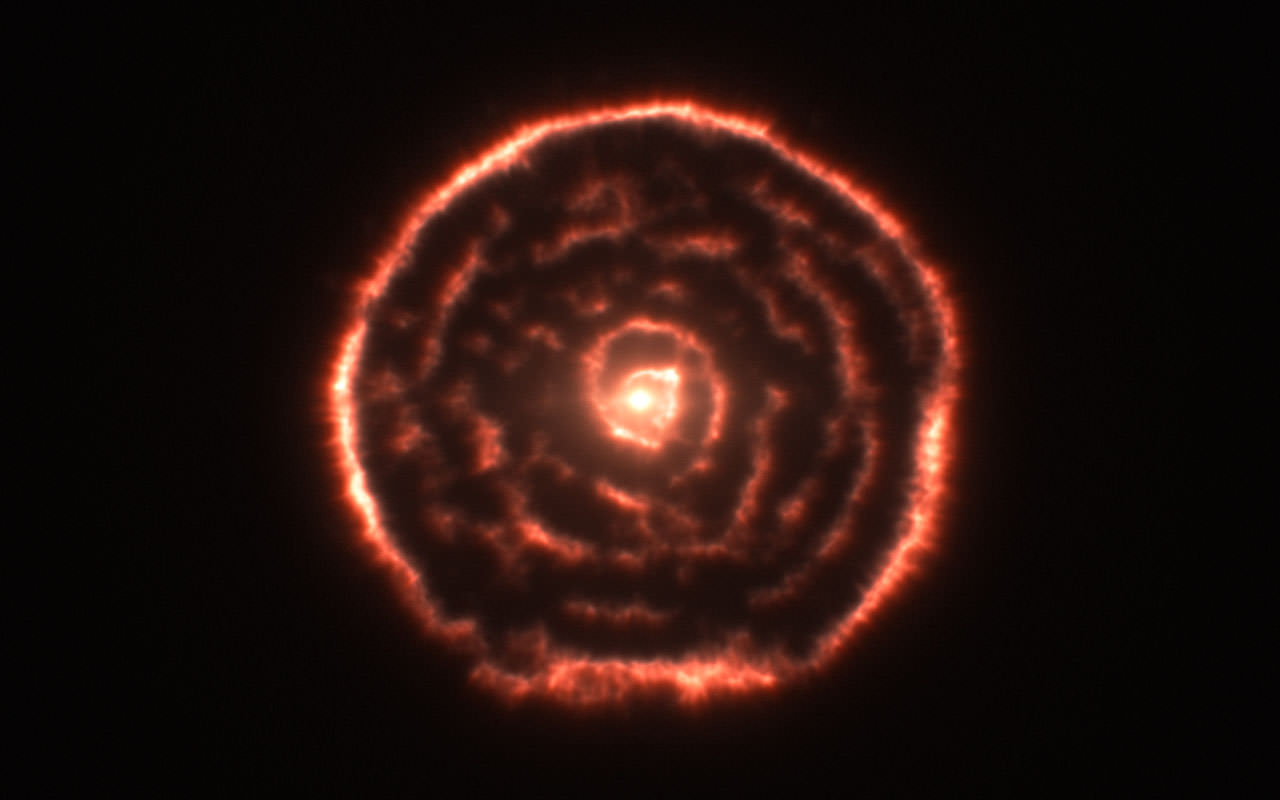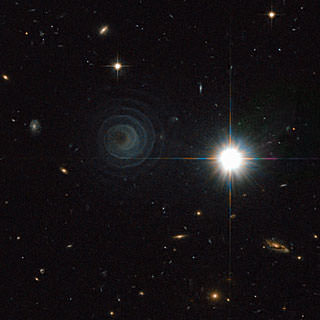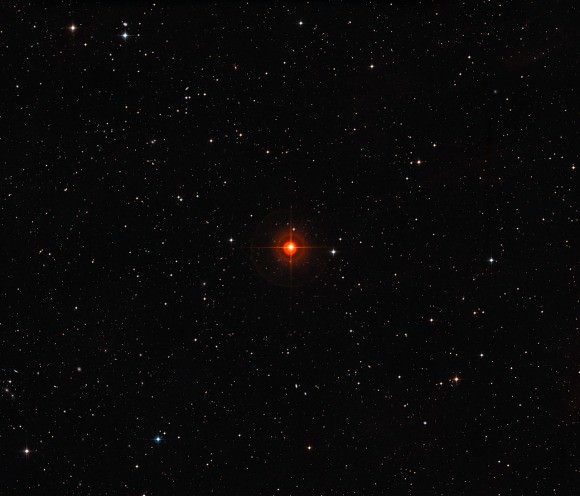Using the Atacama Large Millimeter/submillimeter Array, or ALMA, astronomers found an unexpected spiral structure surrounding the red giant star R Sculptoris shown here in this visualization. Credit: ALMA (ESO/NAOJ/NRAO)
Sometimes what we can’t see is just as surprising as what lies directly in front of us. This especially holds true in a new finding from the astronomers using the Atacama Large Millimeter/sumbillimeter Array, or ALMA, in Chile. A surprising and strange spiral structure surrounding the old star R Sculptoris is likely being created by an unseen companion, say astronomers.
The team using ALMA, the most powerful millimeter/submillimeter telescope in the world, mapped the spiral structure in three-dimensions. The astronomers say this is the first time a spiral of material, with a surrounding shell, has been observed. They report their findings in the journal Nature this week.
“We’ve seen shells around this kind of star before,” says lead author Matthias Maercker of the European Southern Observatory and Argelander Institute for Astronomy, University of Bonn, Germany in a press release. “But this is the first time we’ve ever seen a spiral of material coming out from a star, together with a surrounding shell.”
Scientists, using the NASA/ESA Hubble Space Telescope found a similar spiral, but without a surrounding shell, while observing the star LL Pegasi. Unlike the new ALMA observations, however, the astronomers could not create a three-dimensional map of the structure. Hubble observations saw the dust while ALMA detected the molecular emission.
ALMA detects the warm glow of carbon monoxide molecules in the far infrared through the multimeter wavelengths allowing astronomers to map the gas emissions surrounding the star in high-resolution. The team believes the strangely shaped bubble of material was probably created by an invisible companion star orbiting the red giant.
As stars like our Sun reach the ends of their lives, they become red giants. Swollen and cool, the stars begin a short-lived helium burning phase. During this time, the stars slough off large amounts of their mass in a dense stellar wind forming an expanding glowing shell around the stellar core. The pulses occur about every 10,000 to 50,000 years and last just a few hundred years. New observations of R Sculptoris show a pulse event rocked the star about 1,800 years ago and lasted for about 200 years. Computer simulations following the evolution of a binary system fit the new ALMA observations, according to the astronomers.
“It’s a real challenge to describe theoretically all the observed details coming from ALMA,” says co-author Shazrene Mohamed, of Argelander Institute for Astronomy in Bonn, Germany and South African Astronomical Observatory. “But our computer models show that we really are on the right track. ALMA is giving us new insight into what’s happening in these stars and what might happen to the Sun in a few billion years from now.”
A wide field view of the red giant variable star R Sculptoris. Credit: ESO/Digitized Sky Survey 2. Acknowledgement: Davide De Martin
R Sculptoris is considered by astronomers to be an asymptotic giant branch, or AGB, star. With masses between 0.8 and 8 solar masses, they are cool red giants with a tiny central core of carbon and oxygen surrounded by a burning shell of helium and hydrogen burning. Eventually, our Sun will evolve into an AGB star. The glowing shell is made up of gas and dust, material that will be used for making future stars with their retinue of planets and moons and even the building blocks of life.
“In the near future, observations of stars like R Sculptoris with ALMA will help us to understand how the elements we are made up of reached places like the Earth. They also give us a hint of what our own star’s far future might be like,” says Maercker.
This new video shows a series of slices through the data, each taken at a slightly different frequency. These reveal the shell around the star, appearing as a circular ring, that seems to gets bigger and then smaller, as well as a clear spiral structure in the inner material that it best seen about half-way through the video sequence.
Source: European Southern Observatory
Small image caption: What appears to be a thin spiral pattern winding away from a star is shown in this remarkable picture from the Advanced Camera for Surveys on the NASA/ESA Hubble Space Telescope shows one of the most perfect geometrical forms created in space. It captures the formation of an unusual pre-planetary nebula, known as IRAS 23166+1655, around the star LL Pegasi (also known as AFGL 3068) in the constellation of Pegasus (the Winged Horse). Credit: NASA/ESA Hubble




James Dunlop was the discoverer of R Sculptoris, which was found by him in 1826 from his home in Paramatta, New South Wales in Australia. It appears as Dunlop 3 (Δ3) in his double star catalogue. He describes; “A very singular star of the 7th magnitude, of an uncommon red purple colour, very dusky and ill-defined; 3 obs(ervations) on this star; a small star preceding, and another following.”
Variability was discovered by Benjamin Gould* in 1878, and is the 14th brightest SRB-type variable stars. It is also listed as EsB 26 in the Espin-Birmingham Red Stars.
Spectral Type is C6,5 EA(NP) atypical of a deep-red coloured carbon star, whose E-B is a remarkable +4.8.
* Gould was the first American to receive a PhD in astronomy and the founder of The Astronomical Journal, which printed its first edition in 1849.
wow